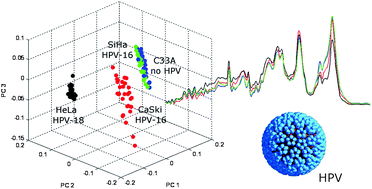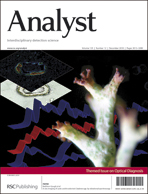The main aetiology of cervical cancer is infection with high-risk human papillomavirus (HPV). Cervical cancer is almost 100% curable if detected in the early stages. Thus, information about the presence and levels of HPV in patient samples has high clinical value. As current screening methods, such as the Pap smear test, are highly subjective and in many cases show low sensitivity and specificity, new supportive techniques are desirable to improve the quality of cervical cancer screening. In this study, vibrational spectroscopic techniques (Raman and Fourier Transform Infra Red absorption) have been applied to the investigation of four cervical cancer cell lines: HPV negative C33A, HPV-18 positive HeLa with 20–50 integrated HPV copies per cell, HPV-16 positive SiHa with 1–2 integrated HPV strands per cell and HPV-16 positive CaSki containing 60–600 integrated HPV copies per cell. Results show that vibrational spectroscopic techniques can discriminate between the cell lines and elucidate cellular differences originating from proteins, nucleic acids and lipids. Similarities between C33A and SiHa cells were exhibited in the Raman and infrared spectra and were confirmed by Principal Component Analysis (PCA). Analysis of the biochemical composition of the investigated cells, with the aid of PCA, showed a clear discrimination between the C33A–SiHa group and HeLa and CaSki cell lines indicating the potential of vibrational spectroscopic techniques as a support to current methods for cervical cancer screening.

You have access to this article
 Please wait while we load your content...
Something went wrong. Try again?
Please wait while we load your content...
Something went wrong. Try again?


 Please wait while we load your content...
Please wait while we load your content...